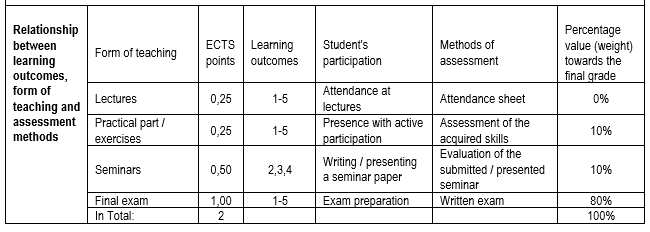he objective of the course is for a student of the study programme in nursing to acquire basic knowledge in physiology, pathophysiology of the metabolism of vitamin D3. Students will be acquainted with clinical manifestations and consequences of vitamin D3 deficiency and ways of its application and effects on the extraskeletal metabolism. Students will be acquainted with the latest immunomodulation effects of vitamin D3 on all body systems. The acquired knowledge should enable the student to gain a better understanding of physiological, pathophysiological and pathological processes in the organism and ways of improving the immune status of patients while mastering the nursing care procedures which ensure long-term mobility and vitality even in the older age.
The course includes the acquisition of knowledge on the structure and function of the vitamin D3 receptor (VDR) and vitamin D3 itself, the physiology and pathophysiology of vitamin D3 metabolism, the biochemical structure of its metabolites, and the way in which it influences the skeletal and extraskeletal status. The education includes:
- Knowledge of the structure and role of VDR and vitamin D3 itself
- Knowledge of hydroxylation in the liver and kidney, as well as the metabolic activity of a single metabolite.
- Explain the mechanism of transcriptional regulation of molecules in VDR in synthesis of new immunoprotective, anti-atherogenic and anti-carcinogenic proteins.
- Describe methods of laboratory diagnostics and methods of determination of individual metabolites.
- Describe the incidence and prevalence of vitamin D3 deficiency.
- Describe the reasons and consequences of the vitamin D3 deficiency in the world and the Republic of Croatia.
- Find out the impact of vitamin D3 deficiency on possible mechanisms of immunodeficiency, cancer, diabetes, multiple sclerosis, asthma and other conditions.
- List the main diseases associated with vitamin D3 deficiency.
- Know the effect of vitamin D3 on bone diseases
- Identify risk groups
Implement preventive measures to raise the level of vitamin D3 in the population
Obavezna literatura:
- Vrhovac B, Jakšić B, Reiner Ž, Vucelić B. Interna medicina. Zagreb: Naklada Ljevak; 2008.
- Vranešić Bender D, Giljević Z, Kušec V, Laktašić Žerjavić N, Bošnjak Pašić M, Vrdoljak E, i sur. Smjernice za prevenciju, prepoznavanje i liječenje nedostatka vitamina D u odraslih. Liječ Vjesn. 2016;138(5-6):121–132.
- Holick MF, Binkley NC, Bischoff-Ferrari HA, Gordon CM, Hanley DA, Heaney RP, i sur. Guidelines for Preventing and Treating Vitamin D Deficiency and Insufficiency Revisited. J Clin Endocrinol Metab. 2012;97(4):1153-8.
Dopunska literatura:
- Feldman D, Pike JW, Bouillon R, Giovannucci E, Goltzman D, Hewison M, ur. Vitamin D – Volume 1: Biochemistry, Physiology and Diagnostics. 4. izd. Academic Press; 2018. str. 1065-89. (poglavlje 57A - The IOM–Endocrine Society Controversy on Recommended Vitamin D Targets: In Support of the IOM Position).
Upon completion of this course, students will be able to:
- explain the structure and function of vitamin D3;
- clarify the mechanisms of signaling and generation of new proteins under the influence of vitamin D3 activity (main immunomodulatory, anticancer, antiatherogenic effects of vitamin D3 and the relationship with other hormones and vitamins);
- interpret normal physiological pathological values, serum levels of vitamin D3;
- explain the epidemiology - prevalence and incidence of vitamin D3 deficiency in the world and in the Republic of Croatia;
- describe the method of diagnosis: laboratory methods, monitoring and measuring the effect of vitamin D3;
- explain the implementation of the screening method for vitamin D3;
- explain non-drug treatments.



